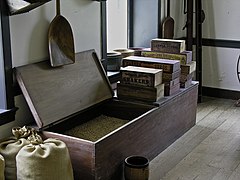
The United Society of Believers in Christ's Second Appearing, more commonly known as the Shakers, are a millenarian restorationist Christian sect founded c. 1747 in England and then organized in the United States in the 1780s. They were initially known as "Shaking Quakers" because of their ecstatic behavior during worship services.
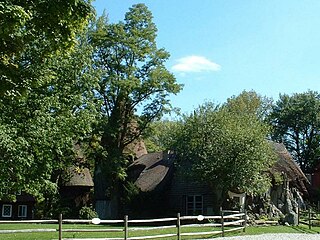
Tyringham is a town in Berkshire County, Massachusetts, United States. It is part of the Pittsfield, Massachusetts Metropolitan Statistical Area. The population was 427 at the 2020 census.

Seed companies produce and sell seeds for flowers, fruits and vegetables to commercial growers and amateur gardeners. The production of seed is a multibillion-dollar global business, which uses growing facilities and growing locations worldwide. While most of the seed is produced by large specialist growers, large amounts are also produced by small growers who produce only one to a few crop types. The larger companies supply seed both to commercial resellers and wholesalers. The resellers and wholesalers sell to vegetable and fruit growers, and to companies who package seed into packets and sell them on to the amateur gardener.

Shaker furniture is a distinctive style of furniture developed by the United Society of Believers in Christ's Second Appearing, commonly known as Shakers, a religious sect that had guiding principles of simplicity, utility and honesty. Their beliefs were reflected in the well-made furniture of minimalist designs.

Mount Lebanon Shaker Society, also known as New Lebanon Shaker Society, was a communal settlement of Shakers in New Lebanon, New York. The earliest converts began to "gather in" at that location in 1782 and built their first meetinghouse in 1785. The early Shaker Ministry, including Joseph Meacham and Lucy Wright, the architects of Shakers' gender-balanced government, lived there.
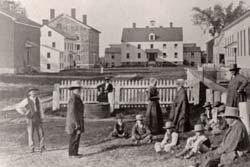
Watervliet Shaker Historic District, in Colonie, New York, is the site of the first Shaker community, established in 1776. The primary Shaker community, the Mount Lebanon Shaker Society, was started a bit later. Watervliet's historic 1848 Shaker meetinghouse has been restored and is used for public events, such as concerts.

Hancock Shaker Village is a former Shaker commune in Hancock and Pittsfield, Massachusetts. It emerged in the towns of Hancock, Pittsfield, and Richmond in the 1780s, organized in 1790, and was active until 1960. It was the third of nineteen major Shaker villages established between 1774 and 1836 in New York, New England, Kentucky, Ohio and Indiana. From 1790 until 1893, Hancock was the seat of the Hancock Bishopric, which oversaw two additional Shaker communes in Tyringham, Massachusetts, and Enfield, Connecticut.
Isaac Newton Youngs was a member of the Shakers. He was a prolific scribe, correspondent, and diarist who documented the history of the New Lebanon, New York Church Family of Shakers from 1815 to 1865.
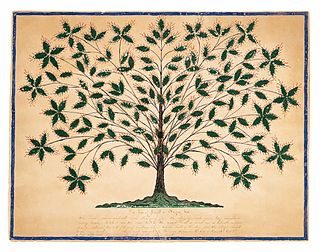
Lucy Wright was the leader of the United Society of Believers in Christ’s Second Appearing, also known as the Shakers, from 1796 until 1821. At that time, a woman's leadership of a religious sect was a radical departure from Protestant Christianity.
Renee Shepherd is a gardening entrepreneur and writer known for heirloom seed advocacy and garden-based cooking using home-grown herbs. Better Homes and Gardens called her "a groundbreaking gardener", and Businessweek a "pioneering innovator" who helped popularize specialty vegetables and cottage garden flowers for home gardening and gourmet restaurants.

The chronology of Shakers is a list of important events pertaining to the history of the Shakers, a denomination of Christianity. Millenarians who believe that their founder, Ann Lee, experienced the Second Coming of Jesus Christ, the Shakers practice celibacy, confession of sin, communalism, ecstatic worship, pacifism, and egalitarianism. This spans the emergence of denomination in the mid-18th century, the emigration of the Shakers to New York on the eve of the American Revolution, subsequent missionary work and the establishment of nineteen major planned communities, and the continued persistence of the faith through decline into the 21st century.

The Shakers are a sect of Christianity which practices celibacy, communal living, confession of sin, egalitarianism, and pacifism. After starting in England, it is thought that these communities spread into the cotton towns of North West England, with the football team of Bury taking on the Shaker name to acknowledge the Shaker community of Bury. The Shakers left England for the English colonies in North America in 1774. As they gained converts, the Shakers established numerous communities in the late-18th century through the entire 19th century. The first villages organized in Upstate New York and the New England states, and, through Shaker missionary efforts, Shaker communities appeared in the Midwestern states. Communities of Shakers were governed by area bishoprics and within the communities individuals were grouped into "family" units and worked together to manage daily activities. By 1836 eighteen major, long-term societies were founded, comprising some sixty families, along with a failed commune in Indiana. Many smaller, short-lived communities were established over the course of the 19th century, including two failed ventures into the Southeastern United States and an urban community in Philadelphia, Pennsylvania. The Shakers peaked in population by the 1840s and early 1850s, with a membership between 4,000 and 9,000. Growth in membership began to stagnate by the mid 1850s. In the turmoil of the American Civil War and subsequent Industrial Revolution, Shakerism went into severe decline. As the number of living Shakers diminished, Shaker communes were disbanded or otherwise ceased to exist. Some of their buildings and sites have become museums, and many are historic districts under the National Register of Historic Places. The only active community is Sabbathday Lake Shaker Village in Maine, which is composed of at least three active members.

The Union Village Shaker settlement was a village organized by Shakers in Turtlecreek Township, Warren County, Ohio.

Watervliet Shaker Village was a Shaker community located in Kettering, Ohio, from 1806 to 1900. Its spiritual name was Vale of Peace and it was within the Union Village bishopric, or governing body.
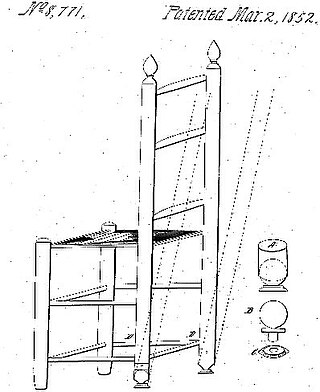
The Shaker tilting chair – named for its ball bearing or ball and socket button mechanism assembled to the back two legs of a wooden chair – allowed a person to lean back in the chair without slipping or scraping the floor.
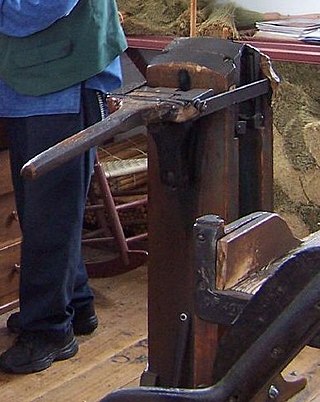
The Shaker broom vise is a specialized production vise that made the normally round broom flat to make it more efficient for cleaning purposes. The Shakers' invention revolutionized the production and form of brooms; in the process greatly expanding an industry in New England.
Job Bishop was an American early Shaker leader. A missionary, he founded the Shaker communities of Canterbury, New Hampshire, and Enfield, New Hampshire.

Mary Wicks Bennett was an American Shaker apostate and magazine editor.

